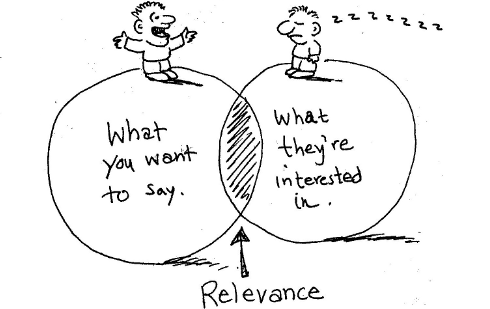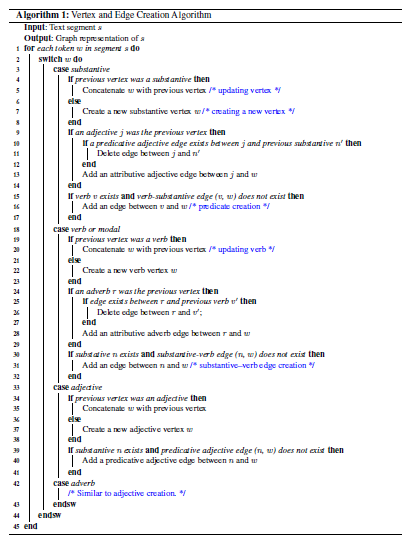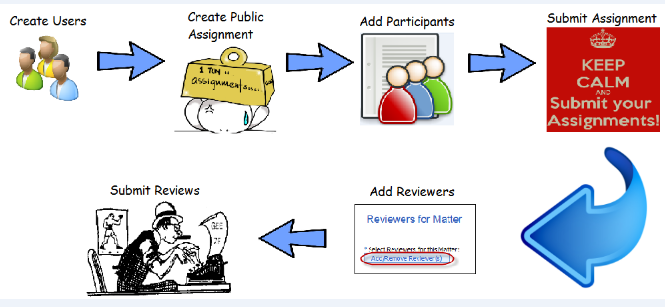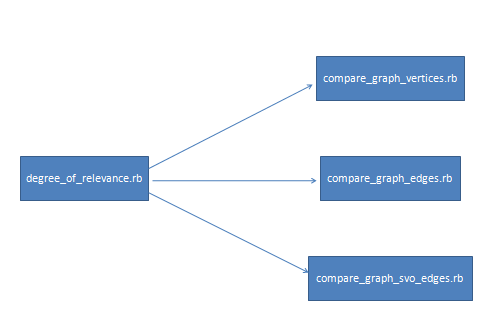CSC/ECE 517 Fall 2013/oss ssv: Difference between revisions
| Line 86: | Line 86: | ||
== Program Flow == | == Program Flow == | ||
[[File:ProgramFlow1.png|frame|none|Program Flow]] | |||
= Implementation = | = Implementation = | ||
Revision as of 09:14, 30 October 2013
Refactoring and testing — degree_of_relevance.rb

Introduction
The class degree_of_relevance.rb is used to how relevant one piece of text is to another piece of text. It is used to evaluate the relevance between the submitted work and review(or metareview) for an assignment. It is important to evaluate the reviews for a submitted work to ensure that if the review is not relevant to the submission, it is considered to be invalid and does not impact student's grade. This class contains a lot of duplicated code and has long and complex methods. It has been assigned grade "F", according to metric like code complexity, duplication, lines of code per method etc. Since this class is important for the research on expertiza, it should be re-factored to reduce its complexity, duplication and introduce coding best practices. Our task for this project is to re-factor this class and test it thoroughly. This class can be found at the following location in expertiza source code - Expertiza\expertiza\app\models\automated_metareview
Theory of Relevance
Relevance between two texts can be defined as:

degree_of_relevance.rb file calculates the relevance between submission and review graphs. The algorithm present in the file implements a variance of dependency graphs called word-order graph to capture both governance and ordering information crucial to obtaining more accurate results.
Word-order graph generation
Vertices represent noun, verb, adjective or adverbial words or phrases in a text, and edges represent relationships between vertices. The first step to graph generation is dividing input text into segments on the basis of a predefined list of punctuation. The text is then tagged with part-of-speech information which is used to determine how to group words into phrases while still maintaining the order. Stanford NLP POS tagger is used to generate the tagged text. The vertex and edges are created using the algorithm below. Graph edges that are subsequently created are then labeled with dependency(word-modifier) information.

WordNet is used to identify semantic relatedness between two terms. The comparison between reviews and submissions would involve checking for relatedness across verb, adjective or adverbial forms, checking for cases of normalizations (noun form of adjectives) etc.
Lexico-Semantic Graph-based Matching
Phrase or token matching
In phrase or token matching, vertices containing phrases or tokens are compared across graphs. This matching succeeds in capturing semantic relatedness between single or compound words.

Context matching
Context matching compares edges with same and different syntax, and edges of different types across two text graphs. We refer to the match as context matching since contiguous phrases, which capture additional context information, are chosen from a graph for comparison with those in another. Edge labels capture grammatical relations, and play an important role in matching.

r(e) and s(e) refer to review and submission edges. The formula calculates the average for each of the above three types of matches ordered, lexical and nominalized. Er and Es represent the sets of review and submission edges.
Sentence structure matching
Sentence structure matching compares double edges (two contiguous edges), which constitute a complete segment (e.g. subject–verb–object), across graphs. In this work we consider only single and double edges, and not more contiguous edges (triple edges etc.), for text matching. The matching captures similarity across segments and it captures voice changes.

r(t) and s(t) refer to double edges, and Tr and Ts are the number of double edges in the review and submission texts respectively. matchord and matchvoice are the averages of the best ordered and voice change matches.
Existing Design
The current design has a method get_relevance which is a single entry point to degree_of_relevance.rb. It takes as input submission and review graphs in array form along with other important parameters. The algorithm is broken down into different parts each of which is handled by a different helper method. The results obtained from these methods are used in the following formula to obtain degree of relevance.

The implementation in Expertiza leaves room for applying separate weights to different types of matches instead of a fixed value of 0.33 in above formula. For example, a possible set of values could be:
alpha = 0.55 beta = 0.35 gamma = 0.1
The rule generally followed is alpha > beta > gamma
Helper Methods
The helper methods used by get_relevance are:
compare_vertices
This method compares the vertices from across the two graphs(submission and revision) to identify matches and quantify various metrics. Every vertex is compared with every other vertex to obtain the comparison results.
compare_edges_non_syntax_diff
This is the method where SUBJECT-SUBJECT and VERB-VERB or VERB-VERB and OBJECT-OBJECT comparisons are done to identify matches and quantify various metrics. It compares edges of the same type ie SUBJECT-VERB edges are matched with SUBJECT-VERB matches.
compare_edges_syntax_diff
This method handles comparisons between edges of type SUBJECT-VERB with VERB-OBJECT. It also does comparison between SUBJECT-OBJECT and VERB_VERB edges. It compares edges of the same type.
compare_edges_diff_types
This method does comparison between edges of different types. Comparisons related to SUBJECT-VERB, VERB-SUBJECT, OBJECT-VERB, VERB-OBJECT are handled and relevant results returned.
compare_SVO_edges
compare_SVO_diff_syntax
Program Flow

Implementation
New Design and Refactoring
New Design
We have taken ideas from the Template design pattern to improve the design of the class. Although we did not directly implement this design pattern on the class, the idea of defining a skeleton of an algorithm in one class, and defering some steps to subclasses, allowed us to come up with a similar design which segregates different functionality to different classes. The following is a brief outline of the changes made:
- Divided the code into 4 classes to segregate the functionality making a logical separation of code.
- These classes are -
- compare_graph_edges.rb
- compare_graph_svo_edges.rb
- compare_graph_vertices.rb
- degree_of_relevance.rb
- Extracted common code in methods that be re-used.
- After refactoring the grade according to codeclimate for the class is "C".
Refactoring
Design of classes
The main class degree_of_relevance.rb calculates the scaled relevance using the formula described above. It calculates the relevance based on comparison of submission and review graphs. As described above the following types of comparison is made between the graphs and various metrics is calculated which is used to calculate the relevance:
- Class compare_graph_edges.rb:
- Comparing edges of graphs with non syntax difference: In this SUBJECT-VERB edges are compred with SUBJECT-VERB matches where SUBJECT-SUBJECT and VERB-VERB or VERB-VERB and OBJECT-OBJECT comparisons are done.
- Comparing edges with syntax diff: Compares the edges from across the two graphs to identify matches and quantify various metrics. Compare SUBJECT-VERB edges with VERB-OBJECT matches and vice-versa where SUBJECT-OBJECT and VERB_VERB comparisons are done - same type comparisons.
- Comparing edges with diff types: Compares the edges from across the two graphs to identify matches and quantify various metrics compare SUBJECT-VERB edges with VERB-OBJECT matches and vice-versa SUBJECT-VERB, VERB-SUBJECT, OBJECT-VERB, VERB-OBJECT comparisons are done. (Different type comparisons)
All the above functions are grouped in one class - compare_graph_edges.rb.
- Class compare_graph_vertices.rb:
- Comparing vertices of the corresponding graphs: Every vertex is compared with every other vertex. Compares the vertices from across the two graphs to identify matches and quantify various metrics.
This method is factored out to the class - compare_graph_vertices.rb
- Class compare_graph_SVO_edges
- comparing SVO edges.
- compare SVO edges with different syntax.
These methods are grouped in the compare_graph_SVO_edges.rb class.
The main class degree_of_relevance.rb calls each of these methods to get the appropriate metrics required for evaluating relevance.
compare_vertices Before Refactoring
How to run the code
Here is a sample of the refactored code compared with original code.
